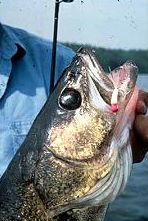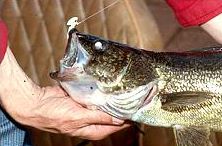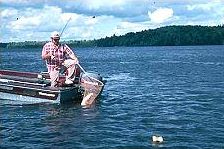Without question, jigs have produced more walleyes than any other lure. They have been bounced along bottom, hung below floats and have even been retrieved at mid ranges for suspended fish. But no matter how good of a jig angler someone is, there are always skills to be sharpened and new tactics to learn.
A long-billed hat, polarized glasses, a gutsy rod with a sensitive tip and a whole lot of concentration are tools of the trade for the serious jig fisherman. But there area many styles, shapes and sized of jigs and a variety of ways to fish them. I’ve been jig fishing for many years and have learned or helped develop numerous techniques. Here are some favorites to cover tough fishing situations.
The River Quiver
Sooner or later the poor wing dam was bound to get a rest. Boat after boat had transported anglers who dragged live bait rigs, jigs and crankbaits across her up-current and down-current edges. This near dam hot-spot was receiving her usual amount of pressure and had yielded a few small male walleyes.
After about a 45 minute lull we decided to move in. Quietly my partner and I slid in two heavy anchors off the bow and stern about 90 feet up current from the rocky structure. Enough rope was let out so our boat ended up a short cast away from the target, and parallel to it. From past experience I know that my go to lure for the current velocity and depth level we planned to fish would be d be a 1/8 ounce marabou-tailed Lindy Fuzz-E-Grub baited with a head-hooked minnow used with 10-pound test line.
The plan was to cast our jig and minnow offerings to the up-current edge of the rocks. It is at this position on the wing dams that more aggressive walleyes and sauger usually hold, favoring cuts, washouts, deeper scattered rocks and anything else that may afford current-deflecting cover. In stained river waters Techni-Glo Fuzz-E-Grubs having some chartreuse on them are especially productive.
After our lures touched bottom we began the quiver–which was basically raising a 6-to 7-foot soft tip rod from a 3 o’clock position to straight up, while constantly quivering or gently shaking the rod tip. The object is to lift the jig as vertically as possible while imparting a “nervous–scared” action to it. We were executing two important tactics for tough to catch fish–use smaller lures and keep them in the fishes face with a teasing up and down presentation.

This was just one of many times this jigging tactic has worked for me. It’s most productive when used against a current flow. Water pushing against the heavier than normal line is what enables you to work the jig in a near vertical manner. A softer tipped rod is a must because you’re reading rod tip action for a take, which is simply a bowing of the rod tip. Use a jig just heavy enough to reach bottom. Generally 1/16 to 1/4 ounce weights are best. Lighter jigs are needed to achieve the proper lift and action. The marabou tail on a Fuzz-E-Grub gives the jig plenty of seductive action from just the river currents.
The Glide
The glide or swimming retrieve is used for walleyes in the weeds, particularly during the summer or early fall when they tend to be more aggressive. The benefits of this retrieve are that it allows for a relatively faster, horizontal jig presentation that can also cover various depth levels.

The glide is best executed with a 6-foot spinning rod with good backbone and a fast tip. Spool up with quality, 6 to 10-pound test line you can see, with pound test based on weed thickness, jig weight and size of walleyes. I use 8-pound test clear monofilament line most of the time.
A key ingredient in this tactic is the correct type of jig. It should be flatter in design with a pointed nose, and the eye tie should be right on the tip. The pointed head will part and slide through the weeds better than any other head design, and the wider body will allow the jig to swim upwards when moved, then glide back down when the retrieve is paused.
After the lure settles to the depth level to be fished (I generally start at the bottom third of the water column), point the rod at the lure and while holding the rod tip about a foot or two above the surface, and begin to reel in the jig. I generally turn the reel handle 2 to 5 times, depending on how high I want the jig to come up, and then pause so the lead head swims back down. The jig is moved by cranking the spinning reel, not by lifting the rod.
If fish are active, 4 or 5 fast turns then a pause while using a 1/4 ounce jig may be the key retrieve. If walleyes won’t chase much, 2 or 3 slower cranks between pauses, while using a 1/8 ounce jig could be the magic formula.
Walleyes often suspend in the weeds. It isn’t uncommon to encounter fish halfway to the surface. And under ideal conditions (low light with aggressive cruising fish), I’ve found them just a few feet under the surface prowling the weed tops for forage. Under these conditions, let the jig sink for 3 to 5 seconds after splashdown and begin a fairly quick crank and pause retrieve. Always watch your line for movement as the jig flutters down between cranks. That’s when almost all hits will occur.
If the weeds are thick nothing works better than Lindy’s No Snagg jigs. There are two styles of jigs I particularly like for “the glide”. If weeds are clingy and an open-hooked jig is hanging too much, a Veg-E-Jig or Timb’r Rock jig is used. Both these jigs have adjustable 7-strand wire guards. Jigs can have a plastic dressing if fish are active, but most of the time they are dressed with a minnow in colder water and a leech during warmer weather.
The Double Drift
At the time I viewed myself as being quite and accomplished jig fisherman. So I was a little shocked and quite humbled when the angler next to me kept catching fish after fish on jigs while I drew blanks. We were both wading a large eddy on the Mississippi River and he was constantly pulling in walleyes, sauger and white bass. I had been successful, but about an hour previously they shut off, at least for me. We were both using jigs and casting up current at about a 45° angle.

After moving closer, watching intently and swallowing my pride enough to ask a few questions, the tactic was figured out. My eddy-sharing colleague was using two lightweight jigs that were rigged in tandem. After the cast was made, the jigs were allowed to tumble down current along bottom. When the drift halted, due to a minor hang on the clean, sand bottom or by a fish sucking it in, a flick of the rod either loosened the jig or buried its sharp, small hook in a fish.
Since that day I’ve successfully fished a tandem jig set-up in current over cleaner bottoms many times. I’m still not sure why it will usually catch far more fish than a single larger jig when fish are not aggressive. The smaller sizes are probably a factor, plus two lures just may be better than one because you can experiment with color and jig type. Also the jig on the short line (a Fuzz-E-Grub) usually catches most fish because it has more of an up and down action, while the other comes in more horizontally.
It’s very important to use enough weight so the jigs hit bottom, but not so much weight that the current can’t drift them across bottom. For some reason two 1/8-ounce jigs will drift better than a single 1/4-ounce jig. This rig works anytime of the year. Its bet fished on a 6 to 7-foot spinning outfit that is rated for lines 6 to 10-pound test. I generally use 6-pound test monofilament or 10-pound test braid with a fluorocarbon leader.
The Shake

“The Shake” is similar to the River Quiver except that with this retrieve the jig is coming toward you, not dancing up and down in the current. This tactic is designed to tease walleyes in deeper water into hitting that refuse the other presentations. It is a last ditch effort to try, because it’s a slow meticulous retrieve that will not allow an angler to cover much water. It is best used in proven pin-pointed areas, on structure-hugging fish seen on a sonar, or after a fish or two had been caught off a spot and you suspect there are others around. The hard-bottomed tip off a big weed flat, isolated fingers and turns off a large bar and a small hump are classic spots to try this retrieve.
It’s important not to waste casts to unproductive parts of a structure, so I generally use a floating structure marker in conjunction with this technique. The marker is not tossed right on the area to be fished, but rather slightly shallower off to the side.
When fishing the 10-15 foot range I try to use a 1/8-ounce jig with 4-pound test mono. For probing bottoms over 15 feet, a 1/4-ounce jig on 6-pound test is standard. Wind, water clarity and cover may require slight adjustments in the presentation.
A soft-bodied jig that has a marabou tail (Fuzz-E-Grub), or one having tiny, sensitive, slivers of plastic off its end (tube style) are recommended. It’s important to dress the jig with live bait–either with a smaller leech or half of large nightcrawler (or whole, smaller one). If the water is stained Techni-Glo Fuzz-E Grubs are deadly. Colors with chartreuse in them seem to be the most productive.
The shaking style retrieve keeps quivering and nodding the jig along bottom to tease the walleye into sucking it in. To make it even more tempting and visible, the leech is hooked behind the suction cup so it swims upward, and the crawler is injected with a bubble of air near its tail with a Lindy Worm Blower. Sometimes a stand-up style head works better than a round head. This is usually when fish are taking the jig during pauses in the retrieve.
An ideal cast splashes down about 15-20 feet past the key spot to be fished. As the lure is sinking make sure the line is constantly peeling off the reel, even if some of it has to be pulled out by hand. If your reel is engaged when the lure hits the water the jig won’t sink straight down, but will come back toward you in an arch, often causing you to miss at least part of the targeted area.
Once the lure rests on bottom, as indicated by the line going a little slack, point the rod tip at the lure and a foot or so above the surface. Gently start shaking the rod while slowly lifting it to a 12 o’clock position. Pause 3-4 seconds, drop the rod tip back to the original position while picking up the slack, and repeat the sequence. A take will show as a dipping of the rod tip as it’s being worked upward. A longer rod (6 1/2 to 7 feet) with a sensitive tip is recommended. This tactic takes big walleyes! I’ve even seen it work great after a spot had been fished with live bait behind slip-sinker rigs.